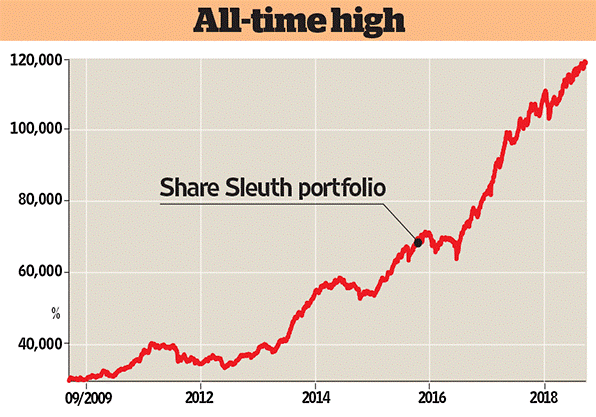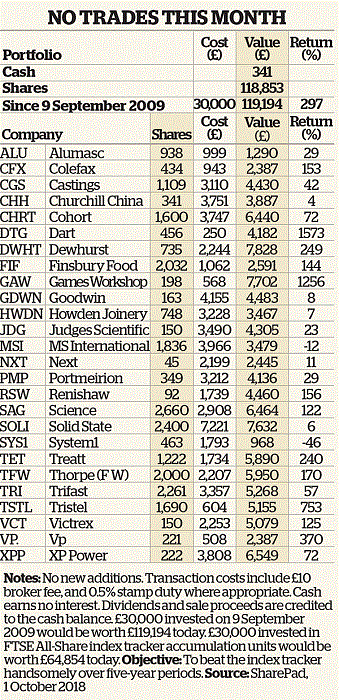How Share Sleuth picks his winning stocks
21st November 2018 11:05
by Richard Beddard from interactive investor
Share on
Deciding whether to buy a share can be a daunting process. Companies analyst Richard Beddard tells us how he does it and provides a valuable investment checklist.

One of the mantras I see wielded by people seeking to improve their performance, be they sportsmen and women, musicians, business people or investors, is the idea of focusing on 'process over outcome'.
Success is determined by our actions and by events outside our control. Progress rarely happens in a straight line: good days and bad days, good years and bad years, are inevitable. If we obsess about outcomes – how our portfolios are doing, for example – as if we were totally in control, we are focusing on the wrong thing. It is not usually where we are today that matters, but whether we are doing the right thing today to achieve our long-term objectives: in other words, whether we are following our process correctly.
This month there are no new trades in the Share Sleuth portfolio, so it is a good time to describe my investment process. It evolves over time, but I apply it whether I am looking at a share for the first time or the fifteenth.
I start with the annual report, but I will also read previous annual reports, and if I need to know more I will go to the annual general meeting and seek answers directly, or research the company's products, suppliers, customers and so on, going wherever the annual report leads me.
Reading the annual report is a two-stage process. I get the numbers from the financial statements and notes, which are at the back of the report, and put them into a spreadsheet. The spreadsheet tells me how profitable and indebted the company is, and the market value of the shares. It also tracks statistics particular to each business. It goes back many years, so I can see how the company has performed through thick and thin.
The second stage is reading the annual report, principally the strategic report which tells me how the firm makes money (the 'business model'), how it will make more money (the 'strategy'), and why it might fail (the 'principal risks'). I also read the remuneration report carefully. Then I score the share out of 10, awarding a maximum of two points for each of five criteria. I want to know that a business is profitable, adaptable, resilient and equitable, and that the shares are cheap.
Profitability is important because a profitable company has already succeeded, which means I only have to work out whether it will continue to prosper. That is the job of the next three criteria.
I need confidence that the firm's strategy will help it adapt to changing circumstances by building on its strengths. For the company to prosper, the strategy must also address the risks it faces. I must know the company is addressing weaknesses.
Additionally, to prosper over the long term, the company must look after employees, customers, suppliers and shareholders, so it should be clear from its policies and strategy that it is equitable and that the board of directors is not paying an unfair share of the profit to itself.

Source: Sharepad, at 1 October 2018
No overpaying
The final criterion, cheapness, measures the market's valuation, since I don't want to pay too much for the shares. Like the other criteria, the cheapest shares score a maximum of two points. Unlike the other criteria, the minimum score is not zero – it is minus two.
- Is simply copying model portfolios a sensible tactic for DIY investors?
- A plain English guide to corporate jargon for results season
I write down my reasons for scoring each category, tot up the scores, and if a share scores seven or more, I deem it suitable for long-term investment. You can see the result of that process in this month's Share Watch column, where I have summarised my thoughts on Cohort, Colefax, Dart and Goodwin. All four are members of the Share Sleuth portfolio.
The outcome so far is in the chart accompanying this article. I won’t be commenting on outcomes until next year, the portfolio's 10th anniversary. Until then I remain focused on process.

Source: interactive investor
These articles are provided for information purposes only. Occasionally, an opinion about whether to buy or sell a specific investment may be provided by third parties. The content is not intended to be a personal recommendation to buy or sell any financial instrument or product, or to adopt any investment strategy as it is not provided based on an assessment of your investing knowledge and experience, your financial situation or your investment objectives. The value of your investments, and the income derived from them, may go down as well as up. You may not get back all the money that you invest. The investments referred to in this article may not be suitable for all investors, and if in doubt, an investor should seek advice from a qualified investment adviser.
Full performance can be found on the company or index summary page on the interactive investor website. Simply click on the company's or index name highlighted in the article.
Disclosure
We use a combination of fundamental and technical analysis in forming our view as to the valuation and prospects of an investment. Where relevant we have set out those particular matters we think are important in the above article, but further detail can be found here.
Please note that our article on this investment should not be considered to be a regular publication.
Details of all recommendations issued by ii during the previous 12-month period can be found here.
ii adheres to a strict code of conduct. Contributors may hold shares or have other interests in companies included in these portfolios, which could create a conflict of interests. Contributors intending to write about any financial instruments in which they have an interest are required to disclose such interest to ii and in the article itself. ii will at all times consider whether such interest impairs the objectivity of the recommendation.
In addition, individuals involved in the production of investment articles are subject to a personal account dealing restriction, which prevents them from placing a transaction in the specified instrument(s) for a period before and for five working days after such publication. This is to avoid personal interests conflicting with the interests of the recipients of those investment articles.
This article was originally published in our sister magazine Money Observer, which ceased publication in August 2020.
These articles are provided for information purposes only. Occasionally, an opinion about whether to buy or sell a specific investment may be provided by third parties. The content is not intended to be a personal recommendation to buy or sell any financial instrument or product, or to adopt any investment strategy as it is not provided based on an assessment of your investing knowledge and experience, your financial situation or your investment objectives. The value of your investments, and the income derived from them, may go down as well as up. You may not get back all the money that you invest. The investments referred to in this article may not be suitable for all investors, and if in doubt, an investor should seek advice from a qualified investment adviser.
Full performance can be found on the company or index summary page on the interactive investor website. Simply click on the company's or index name highlighted in the article.